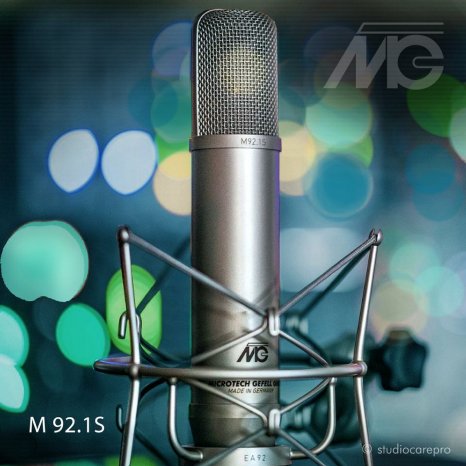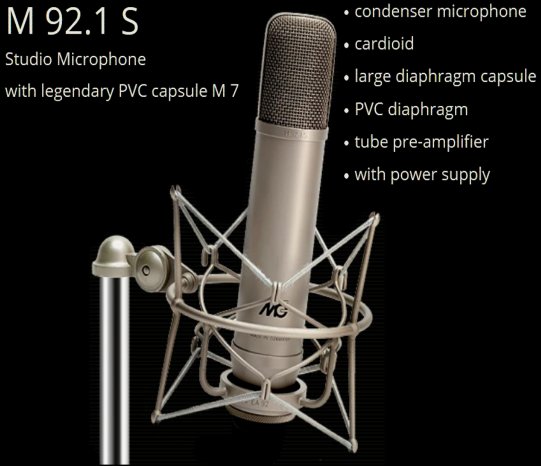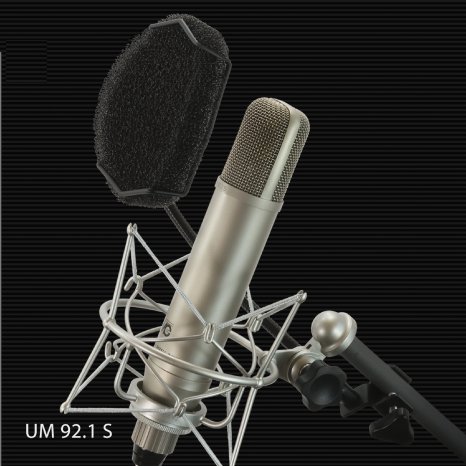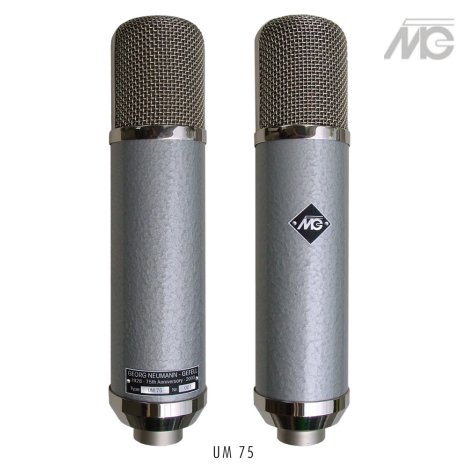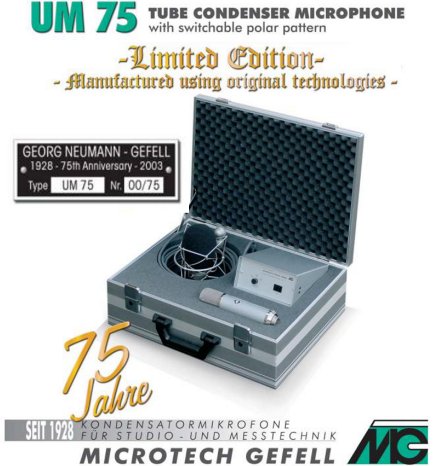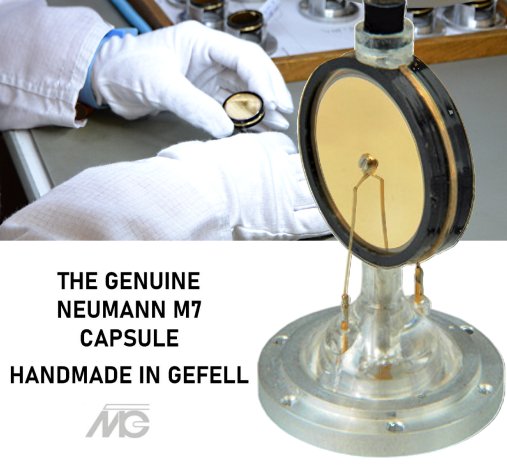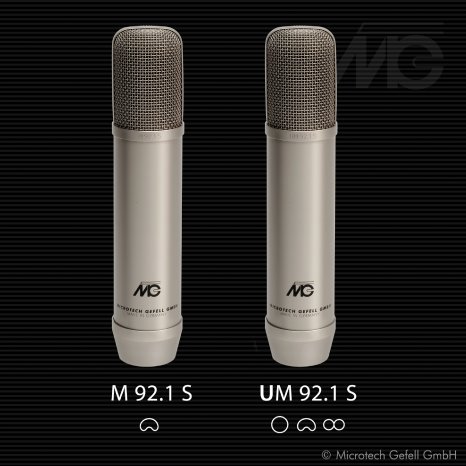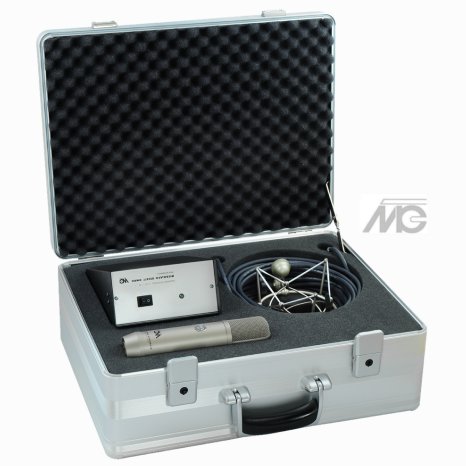Tube condenser microphones have been appreciated in the audio field since 1928, after Georg Neumann succeeded in mass-producing the first commercial tube microphone, the CMV3, called "the bottle".
Even though tube microphones have become rarer since the establishment of solid-state/FET condenser microphone technology, they are still among the most sought-after microphones in professional studios worldwide.
Tube microphone technology is still highly valued in professional audio for their characteristic "tube sound", especially by singers and soloists.
This also applies to the legendary Gefell tube microphones, such as the M 92.1 S family.
Their unique sound quality is based on the legendary, handmade, large-area, gold-plated Neumann PVC double-diaphragm capsule of type M 7 and an excellent signal-to-noise ratio paired with high sensitivity as well as decades of experience with modern microphone design.
The roots of the Gefell M 92.1 S / UM 92.1 S microphones
The roots of the classic tube M 92.1 S and its switchable variant, the UM 92.1 S, go back to the late post-war period.
In the 1950s, the broadcasting stations in Berlin were rebuilt and the microphone production of Georg Neumann & Co. in Gefell continued under the difficult conditions of the centralised socialist economy of scarcity. The challenge for Gefell as a private company in GDR times was that the procurement of raw materials was extremely regulated by the state authorities. In 1956 the Georg Neumann & Co. therefore had to accept state co-ownership and, like thousands of other private companies, became a so-called "company with state participation". Despite all the associated adversities, there were still close contacts with the founder Georg Neumann until the Berlin Wall was erected in 1961. He was concerned about his employees in Gefell and offered his help in the further development of the company. As a result, a number of new developments were realised in the late 1950s, including the legendary UM 57.
The UM 57 - The forefather of a new, contemporary microphone family
The market launch of the legendary UM 57, which is still in demand today, the forefather of today's M 92.1 S / UM 92.1 Sdates back to 1957.
The Neumann/Gefell Multi-Pattern UM 57 was a large-diaphragm microphone with the famous hand-made M7 PVC double-diaphragm capsule. Via a switch on the power supply it allowed 3 polar patterns (omnidirectional, cardioid, figure-of-eight).
The M7 tradition is still of central importance for Microtech Gefell/MTG today. MTG, as a company of Georg Neumann & Co, i.e. Neumann's original company from 1928, is until today the sole manufacturer of the M7 original and service partner for all historical microphones manufactured in Gefell.
As soon as it was introduced to the market, the UM 57 became an Eastern European export hit.
In the West, Neumann/Gefell microphones were less well known due to the Cold War.
Nevertheless, Neumann/Gefell microphones also attracted attention in the Western hemisphere.
This was due, among others, to a 1965 film recording of Louis Armstrong in Prague's Lucerna Hall with legendary Gefell tube classics, such as the CMV 563 or UM 57.
However, due to export restrictions, Neumann Gefell- microphones were difficult to obtain on Western markets. There are stories of US customers who had Neumann/Gefell microphones smuggled into the USA via Cuba.
The UM 75 Vintage Microphone - A Special Edition for MTG's 75th Anniversary as a Tribute to Georg Neumann
A quarter of a century after its market launch, MTG presented the UM 75 Vintage Edition in a strictly limited edition as a contemporary replica of the legendary UM 57.
Instead of EC 92 triodes, specially selected Russian EF86 pentodes were used, as well as updated circuits similar to those of the UM 92.1 S (itself a modern reinterpretation of the UM 57) and AMI/Tab-Funkenwerk Transformers, specially developed for Gefell.
The UM 92 S - One step further in development.
The differences between the UM 92 S and the later UM 92.1 S are the output transformer, the tube and the noise-cancelling circuit.
The UM 92 S studio microphone (and the M 92 S as a pure cardioid version), a later further development of the UM 57, is also based on an M7 large-double-diaphragm capsule and a vacuum tube.
The polar pattern (omnidirectional, cardioid, figure-of-eight) can be selected with a switch integrated in the power supply. An EF 92 triode (later an EF 86 pentode in the UM 92.1S) is used in the tube preamplifier.
The capsule polarisation voltage and the necessary preamplifier DC voltages were supplied by the UN 920 power supply (115 or 230 volts / 50 or 60 Hz).
In difference to the later UN 920.1 S, the UN 920 did not yet have a heater voltage setting, which is important for cable lengths over 50 metres.
The UM 92.1S - The Up To Date Interpretation of the UM 92 S
The UM 92.1S, as a switchable version of the M 92.1 S, is a "large-diaphragm multi-pattern tube microphone, equipped with the classic M7 capsules, selected for optimum directional characteristics.
Like its predecessors, the pressure-gradient receiver features a large, handmade, gold-plated, PVC dual-diaphragm capsule.
It is the first choice for those who want the true sound and character of the classic Neumann UM 57 with the added benefit of improved reliability and reduced noise.
The UM 92.1S features a remarkable signal-to-noise ratio and high sensitivity.
The tube preamplifier is a proven design with an EF 86 pentode operating as a high-μ triode. The tubes are carefully selected for their acoustic behaviour.
All electrical and mechanical characteristics are optimised for performance. By mounting the M7 on a special base, the vortex around the microphone and capsule is reduced to a maximum. This has the advantage of directing unwanted reflections away from the capsule, reducing comb filtering and phase noise.
The compact enclosure offers the advantage of greater freedom for positioning in tighter places, while reducing the so-called vortex around the microphone.
Following a long tradition, a natural presence boost adds clarity and detail "on-axis", while the "off-axis" transition is both smooth and musical.
The familiar low-frequency proximity effect provides a warm bottom end that is enhanced when the sound source is brought closer to the diaphragm.
For long cable runs, a filament voltage stabilizer is built into the microphone that allows distances of up to 100 meters (328feet) without fluctuation.
The microphones are equipped with an elastic suspension (spider) that reduces the influence of structure-borne sound on the microphone. The spider is attached to the base of the microphone. This allows the microphones to be positioned at any angle without hesitation.
The UM 92.1 S with its own power supply, the UN920, provides the capsule polarisation voltage as well as the DC voltage for the microphone amplifier. The UN 920.1 can be operated with 115 V or 230 V / 50 Hz or 60 Hz.
The switch for the directional characteristics and the on/off switch are located on the front panel.
On the back are the 7-pin Tuchel connector for the microphone connection, the 3-pin XLR connector for the audio output and the unit plug voltage selector switch.
